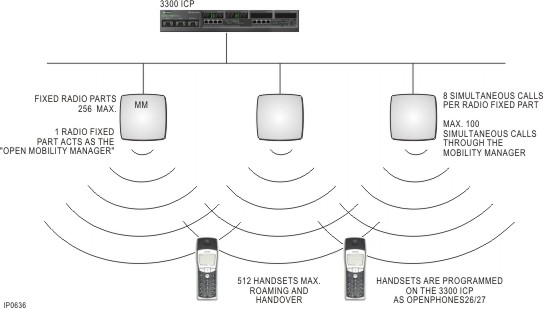
The Mitel Internet Protocol Digital Enhanced Cordless Telecommunications (IP-DECT) wireless solution is available in the EMEA (Europe, Middle-East and Africa) market only. It consists of the following components:
3300 ICP
Radio Fixed Parts (base stations)
Open Mobility Manager (IP-DECT wireless solution administration application)
OpenPhones (wireless phones)
The Radio Fixed Parts (RFPs) connect to
the 3300 ICP through the LAN. The wireless phones communicate
with the RFPs using standard Digital Enhanced Cordless Telecommunications
(DECT) protocol. One of the RFPs
is designated as the active or primary Open Mobility Manager (OMM).
Another RFP is designated as the standby or secondary
OMM. Like the other RFPs, the Open Mobility Manager
transmits voice information to and from the wireless sets, but it also
provides a management interface that enables you to configure the wireless
system settings, RFPs, and OpenPhones.
Mitel IP-DECT Wireless Solution

With Release 2.0, both Open Mobility Manager (OMM) Resiliency and OpenPhone Resiliency are supported. To support OMM Resiliency, two Open Mobility Managers have to be configured in an OMM network; one working as the primary or active, and the other working as the secondary or standby OMM. In the event that the RFP designated as the primary OMM fails, the other RFP, designated as the secondary OMM, automatically assumes the role of Open Mobility Manager. OpenPhone Resiliency ensures resilient phones remain operational in the event that a phone's primary 3300 ICP fails over to a secondary 3300 ICP.
See the following documentation on the Mitel Customer Documentation web site for instructions on how to install and program the IP-DECT (EMEA) Wireless Solution:
Site Survey Instructions: provides instructions on how to use the DECT Site Survey Kit to determine the most suitable locations for the Radio Fixed Parts (RFPs). In order to survey the WLAN portion of your network, you will need to engage a third party to perform and certify your WLAN.
Mitel IP-DECT Technical Manual - provides an overview of the IP DECT wireless solution and provides site survey, installation, configuration, and maintenance procedures. This manual is available from the Mitel Customer Documentation site.
Radio Fixed Part Specification: describes the operating conditions of the RFPs and provides mounting instructions. This specification is shipped with the RFPs.
Mitel 3300 ICP OpenPhone 27 Handset User Guide: provides instructions on how to install the batteries, charge the batteries, customize handset operation, and use the handset features and 3300 ICP system features. See About the 3300 ICP Documentation Set for information on the telephone user guides.
DECT Monitor Online Help: provides help on using the DECT Monitor management application.
Hot Desking is not supported for the OpenPhone 27.
See the OpenPhone 27 IP-DECT User Guide on the Mitel Customer Documentation web site.